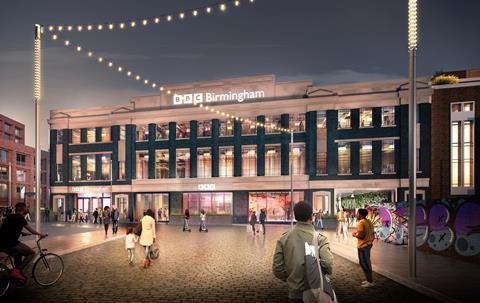Joe Holyoak ponders whether Birmingham can save one of the last remnants of its small-scale industrial urbanism

If you walk south east from Future Systems’ shiny Selfridges building in Birmingham, in two minutes you will be in the district of Digbeth. It’s an untidy, heterogeneous quarter, in the process of transitioning from an industrial district of small workshops into something more complicated. You are likely to find an art gallery next door to a black cab repairer, and a night club next door to a metal recycling business.
It is covered by two conservation area designations, both of them classified by Historic England as at risk, which are being combined into one. It is very different from most people’s image of a conservation area. Historic England writes “Cool, funky and beautiful, Digbeth is one of Britain’s most varied, dynamic and colourful inner-city areas”. (Much as I love Digbeth, I think ”beautiful” may be going a bit too far).
The district is of mediaeval origin, and was once home to a deer park. By the 17th century it was a metal manufacturing area, which produced thousands of weapons for the Parliamentarians in the Civil War. The fast-flowing river Rea, the city’s hidden river, provided power to several mills – manufacturing not flour but metal. Later the Warwick canal arrived, bridging the river on an aqueduct, and later still the blue brick viaducts of the Great Western, and London and North Western railways.
The fine-grained diversity of Digbeth has long been threatened by inappropriate development. The High Speed 2 terminal of Curzon Street is being built on the northern edge of Digbeth. At the same time as severing Digbeth from the city centre, it is likely to encourage the growth of city centre-scale development and economic uses into an area typified by small scale and diversity.
Existing planning control for Digbeth is inadequate. The conservation area management plans are weak and conservative. A new Supplementary Planning Document for the quarter is promised: but it has been promised for a long time. The distinctive character of Digbeth is very vulnerable.
There are now two new and significant development proposals for Digbeth. At this early stage, it is possible that they might represent either a threat or a sign of hope for the special quality of the quarter.

Firstly, BBC Midlands is going to move into Digbeth. One of several booster-labels that have been attached to Digbeth over the years is that of being Birmingham’s “Creative Quarter” and this move may be a good fit.
BBC Midlands is currently in the Mailbox, Associated Architects’ mixed-use conversion of the old 1970s Royal Mail building, which sits on the opposite side of the city centre. Before that, the BBC was in the 1971 Pebble Mill studios in Edgbaston, one of many good John Madin-designed buildings that have since bitten the dust.
The BBC’s proposed new location is the massive ex-Ty-Phoo tea factory, one of two exceptions to Digbeth’s small scale morphology (the other is Alfred Bird’s custard powder factory). Ty-Phoo consists of four contiguous buildings designed by Harry Weedon, the architect of the Odeon cinemas, which occupy almost an entire street block. They date from 1929, 1938, 1947 and 1950: they are locally listed, very neglected, and only partly occupied.
Behind the buildings is a big canal basin, where crates of tea arrived via the Warwick canal. The site has enormous potential for a carbon-conserving development which could contribute greatly to the Digbeth character, as well as generating new investment nearby. Will it be delivered? Glenn Howells Architects are commissioned to deliver the scheme, and their initial proposals are currently out to public consultation.

The second new development proposal is for film studios planned by Steven Knight, titled Digbeth Loc. Steven Knight is best known as the creator of the BBC’s Peaky Blinders, and there is both an appropriateness and an irony in his choice of Digbeth for his new studios.
Appropriate because Digbeth, when it still contained a lot of mean working-class housing mixed up with industry, was one of the major areas in the city for criminal street gangs – not fashion trend-setters, but nasty thugs.
Ironical, because the Peaky Blinders series, though promoted as representing Birmingham, has never been filmed there. The city’s passion for continually remaking itself means that there are no suitable period locations where Peaky Blinders could be filmed. Digbeth would have been suitable, had the housing not all been cleared away.
One hopes that the sensitivity of Steven Knight to locale will result in a development that makes a positive contribution to the complicated layered fabric of Digbeth. There is a history to be told of the Digbeth Loc site, but no space to tell it here: it will have to wait until another column.
Postscript
Joe Holyoak is an architect and urban designer practising in Birmingham.
















No comments yet